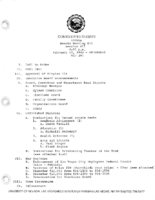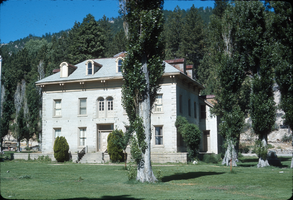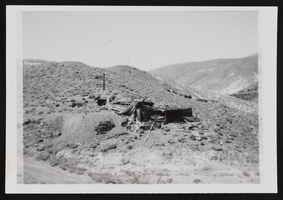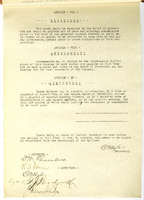Search the Special Collections and Archives Portal
Search Results

Meeting minutes for Consolidated Student Senate, University of Nevada, Las Vegas, February 23, 1983
Date
Archival Collection
Description
Text

Slide of the Bowers Mansion, Washoe Valley, Nevada, circa 1970s
Date
Archival Collection
Description
Image

Map showing detailed topography of the country traversed by the reconnaissance expedition through southern & southeastern Nevada, 1869 (reproduction)
Date
Description
no. 1. Reproduction. Map is printed in purple. Scale of original map: [1:760,320]. 1 in. to approx. 12 miles. Includes dots hand-colored with red pencil marking Indian rancherias.
Image

Transcript of interview with Russell Grater by Frederick Dougan, February 10, 1977
Date
Archival Collection
Description
On February 10, 1977, Frederick Dougan interviewed Russell Grater (born 1907 in Lebanon, Indiana) about his career in the U.S. National Park Service. Grater first talks about his move to the Southern Nevada area and his work that impacted the Hoover Dam project. He then talks about the town of St. Thomas, Nevada, the Lost City, and the activities of tourists. Grater also talks about his work in excavation, the indigenous American Indian tribes of the area, findings on petroglyphs, and the types of wildlife that were found in the area. He later talks about findings related to fossils, gold mining, the effects of World War II on the dam project, and vegetation in the area.
Text
Emerson, David
David W. Emerson was born in Littleton, Massachusetts. His father, a mining engineer, moved the family to Mexico twice, once when he was one year old and again when he was seven. In 1938, his father retired to work on his apple orchard in
Littleton. Emerson helped with pruning, spraying and dusting for insects, and hauling apples to the cider mill.
Person
Denton, Hazel Baker, 1887-1962
Hazel Baker Denton (1887-1962) was a prolific writer, educator, active community member, and elected to serve the Nevada State Assembly in the early 1950s.
Person
Wells, Herbert C., 1927-2010
Herbert C. Wells was born April 11, 1927 in Omaha, Nebraska. After his father was killed in a plane crash in 1931, his mother moved herself and Wells to Los Angeles, California to be near her husband's parents. They moved several times, but the goal was always to find good schools for Wells and his sister.
Person

Candelaria Ruins of Mt. Diablo, Nevada: photographic prints
Date
Description
Image

